Welcome to my friendly guide to food cutting methods! Today, we will explore the culinary world of diced vs minced, uncovering the differences between these two cutting techniques and discovering how they can enhance your cooking.
- Dicing involves cutting food into neat, uniform cubes, while mincing results in finely chopped ingredients.
- Vegetables and fruits are commonly diced, while herbs and garlic are often minced.
- Both methods require sharp knives and proper knife skills for precise cuts.
- Other cutting methods in the culinary world include slicing, bias slicing, chiffonade, and wedges.
- Gripping the knife properly and creating stability while cutting is essential.
Now that we’ve covered the basics, let’s dive deeper into each cutting method and explore when to use diced or minced ingredients. Mastering these techniques will not only save you time but also boost your confidence in the kitchen.
What is Dicing?
Let’s start by understanding what dicing is all about. Dicing is a food cutting method that involves cutting ingredients into neat, uniform cubes. This technique is commonly used for vegetables and fruits, creating evenly-sized pieces that can be easily incorporated into a variety of dishes.
When dicing, it’s important to use a sharp knife and proper knife skills to achieve precise and consistent results. The size of the dice can vary depending on the recipe and personal preference. Smaller dice, such as a 1/4-inch dice, are ideal for dishes like salsas or stir-fries where fast and even cooking is desired. On the other hand, larger dice, like a 1-inch dice, are great for stews or roasted vegetables where a chunkier texture is desired.
Dicing is a versatile cutting technique that can add visual appeal to your dishes and ensure even cooking. By mastering the art of dicing, you can elevate your culinary skills and create professional-looking meals at home.
| Dicing Technique | Advantages |
|---|---|
| Creates uniform cubes | Ensures even cooking |
| Enhances presentation | Provides textural variety |
| Allows for precise portion control | Offers consistent taste throughout |
How to Dice Ingredients
Now that you know what dicing is, let me walk you through the process of dicing your ingredients like a pro. Dicing is a great technique for achieving uniform and visually appealing cuts in your fruits and vegetables. Whether you’re preparing a stir-fry or a fresh salad, dicing your ingredients adds a professional touch to your dish.
Start by selecting a sharp knife that suits the size of the ingredients you’re working with. A chef’s knife or a santoku knife are excellent options for dicing. Remember to keep your fingers tucked away and your non-dominant hand in a claw-like shape to protect your fingertips while cutting.
Begin by trimming off any stems, ends, or peels from your ingredients. Then, slice your ingredient into flat, even pieces. For example, if you’re dicing an onion, cut it in half from top to bottom, peel off the skin, and lay it flat on your cutting board. Next, make horizontal cuts across the onion without slicing all the way through. Finally, make vertical cuts to create small, evenly-sized cubes.
Repeat this process with your remaining ingredients until everything is neatly diced. And voila! You now have perfectly diced ingredients ready to enhance the flavors and aesthetics of your culinary creations. Practice makes perfect, so don’t worry if your first attempts aren’t flawless. With time and experience, you’ll become more confident and efficient in dicing your ingredients with precision.
Pro Tip: Use a Template
If you want to achieve perfectly uniform dice every time, consider using a template. You can easily make your own by cutting out a piece of cardboard or plastic in the desired size of your diced cubes. Simply lay the template over your ingredient and use it as a guide for your knife cuts. This handy tool can help you achieve consistent results and impress your guests with your knife skills.
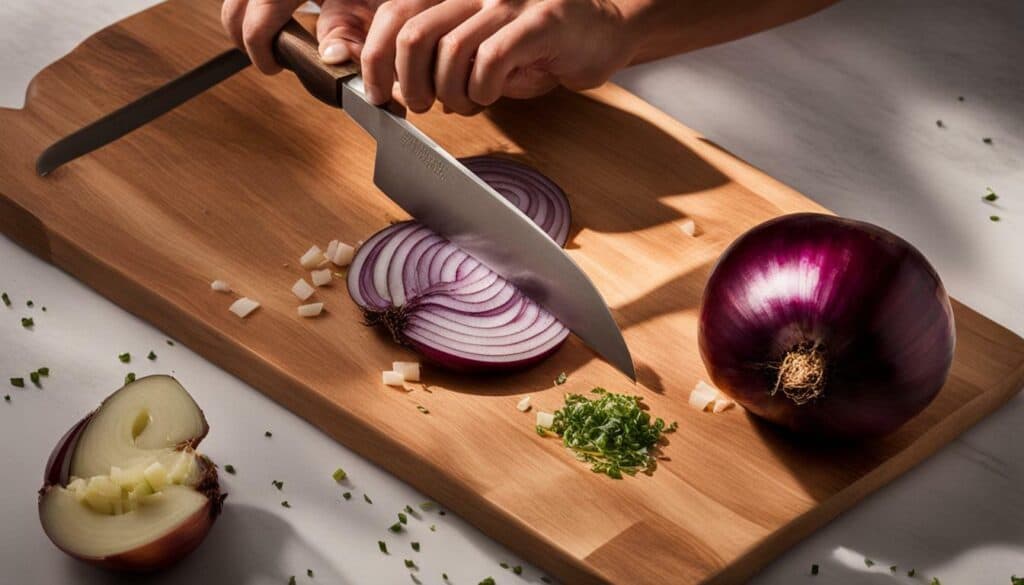
| Ingredient | Dice Size | Cutting Technique |
|---|---|---|
| Onion | Small cubes | Horizontal and vertical cuts |
| Carrot | 1/4 inch slices | Diagonal cuts followed by vertical cuts |
| Potato | 1/2 inch cubes | Horizontal and vertical cuts |
| Bell pepper | 1/2 inch squares | Remove seeds and membrane, then horizontal and vertical cuts |
Remember, dicing your ingredients not only adds visual appeal to your dishes but also ensures even cooking and distribution of flavors. So why not take your cooking skills to the next level and start dicing your ingredients like a pro?
When to Use Diced Ingredients
Diced ingredients have their own unique advantages and are best suited for certain recipes. The precision of dicing allows for even cooking and consistent texture in dishes. When you want the flavors of the ingredients to stand out and provide a burst of flavor in each bite, dicing is the way to go.
One of the main advantages of dicing is that it helps to retain the shape and integrity of the ingredients. This is especially important when you want the dish to have visual appeal, such as in salads or stir-fries. Diced vegetables, like carrots and bell peppers, add a pop of color and texture to your dishes.
Additionally, diced ingredients are ideal when you want a chunkier texture in your meals. For example, in stews or soups, dicing the meat and vegetables ensures that they hold their shape and provide a satisfying bite. The uniformity of the diced pieces also allows for even cooking, resulting in a well-balanced dish.
Diced vs Minced: A Comparison
To compare diced and minced ingredients, it’s important to consider the desired outcome of the dish. While dicing is suitable for recipes that require visual appeal, texture, and even cooking, mincing is preferred when you want a more intense flavor distribution throughout the dish.
Mincing ingredients, such as garlic and herbs, releases their natural oils and flavors, infusing the entire dish with their essence. This is especially beneficial when you want a strong flavor profile, such as in sauces, dressings, or marinades. Mincing creates smaller, finer pieces that easily blend into the other ingredients, enhancing the overall taste.
Both dicing and mincing techniques require proper knife skills, so it’s important to practice and improve your cutting techniques. By mastering these methods and using the right knives, you can elevate your cooking skills and create delicious meals that impress both visually and gastronomically.
| Advantages of Dicing | Advantages of Mincing |
|---|---|
| Diced ingredients provide visual appeal and add texture to dishes | Mincing intensifies flavors and distributes them evenly |
| Retains shape and integrity of ingredients | Creates smaller, finer pieces that blend well with other ingredients |
| Ensures even cooking and consistent texture | Infuses dishes with the essence of herbs and spices |
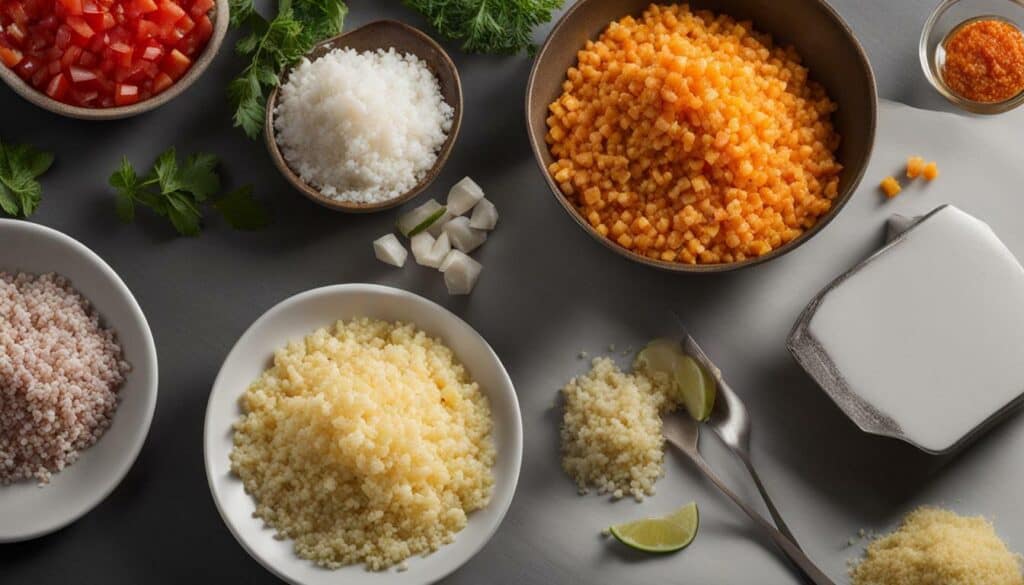 By understanding the differences between dicing and mincing, you can choose the cutting technique that best suits your recipe. Whether you want to enhance the visual appeal, create a chunky texture, or intensify the flavors, dicing and mincing offer their own unique advantages. So grab your knife, sharpen your skills, and get ready to elevate your cooking to the next level!
By understanding the differences between dicing and mincing, you can choose the cutting technique that best suits your recipe. Whether you want to enhance the visual appeal, create a chunky texture, or intensify the flavors, dicing and mincing offer their own unique advantages. So grab your knife, sharpen your skills, and get ready to elevate your cooking to the next level!What is Mincing?
Moving on from dicing, let’s now dive into the world of mincing. Mincing is a cutting technique that involves finely chopping ingredients into small, uniform pieces. This method is commonly used for herbs, garlic, and other aromatic ingredients that need to release their flavors quickly.
To mince ingredients, start by finely chopping them with a sharp knife. It’s important to maintain control and precision while cutting to achieve consistent results. The finer the chop, the more intense the flavor will be. Mincing is ideal for incorporating ingredients seamlessly into sauces, dressings, or marinades.
When mincing, keep in mind that the size of the minced pieces should be smaller than those in dicing. This ensures that the flavor of the ingredient is evenly distributed throughout the dish. Additionally, mincing can help soften the texture of ingredients like garlic, making them easier to incorporate into dishes without overpowering the other flavors.
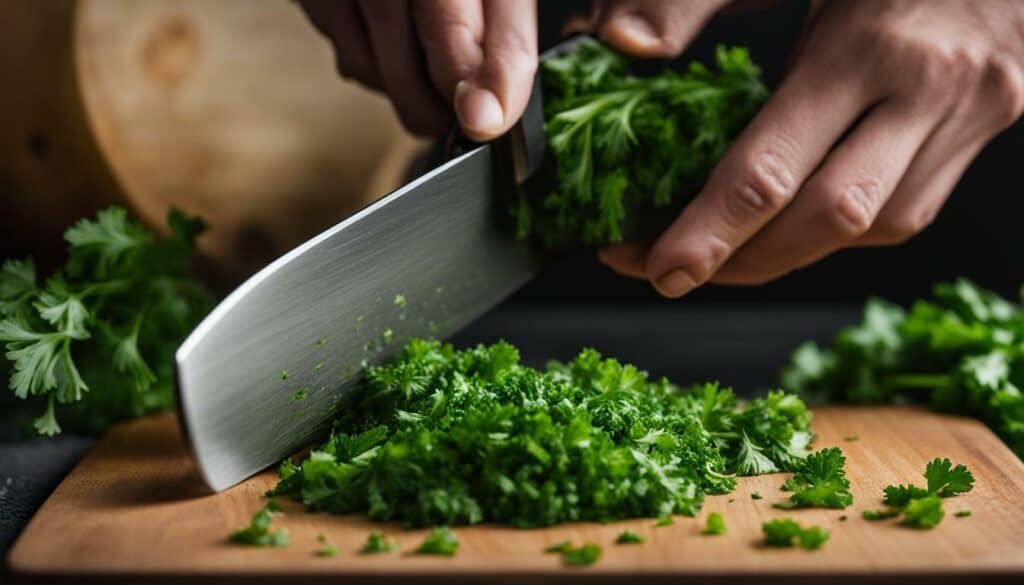
In summary, mincing is a technique that finely chops ingredients into small, uniform pieces. It is commonly used for herbs, garlic, and other aromatic ingredients. By mastering the art of mincing, you can enhance the flavors of your dishes and create a harmonious blend of ingredients.
How to Mince Ingredients
Ready to become a master at mincing? Let’s learn the proper technique together. Mincing is a versatile cutting method that involves finely chopping ingredients. It’s commonly used for herbs and garlic to release their flavors, creating a more subtle and evenly distributed taste in your dishes.
To begin mincing, start by gathering your ingredients and a sharp knife. A chef’s knife is ideal for this task as it provides better control and precision. Begin by holding the knife firmly with your dominant hand, and using your other hand to hold the ingredient you want to mince. Make sure to curl your fingers under and tuck them in to protect them from the blade.
With the ingredient securely in place, start cutting back and forth in a quick, rocking motion. Use the tip of the knife to guide the blade and keep your fingers and knuckles in a safe position. Continue mincing until the ingredients are finely chopped to your desired consistency.
Remember, practice makes perfect when it comes to mincing. With time, you’ll develop the skills and confidence to mince ingredients effortlessly. So sharpen your knife, gather your ingredients, and let’s get mincing!
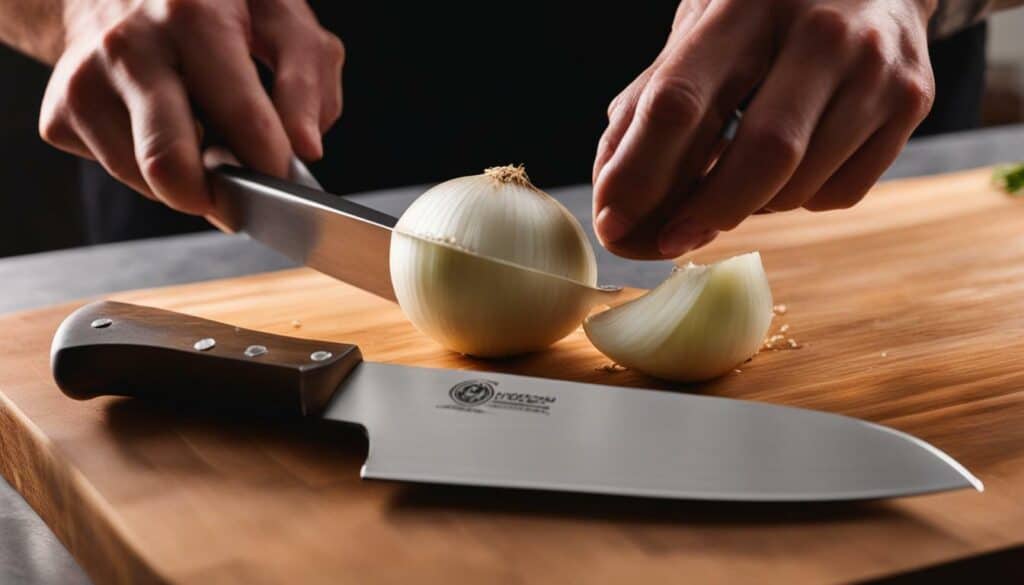
- Ensure your cutting board is stable and secure before you start.
- Keep your knife sharp to make mincing easier and more precise.
- Use a rocking motion to create a consistent, even chop.
- Take breaks if needed to prevent your hand from tiring.
- Experiment with different ingredients and flavors to enhance your culinary creations.
Mincing Techniques:
| Ingredient | Technique |
|---|---|
| Garlic | Smash the garlic clove with the flat side of your knife, then mince the crushed garlic. |
| Herbs | Hold the herbs tightly and gently chop in a rocking motion. |
Diced vs Minced: A Comparison
It’s time to put diced and minced side by side and explore their differences. While both techniques involve cutting ingredients into smaller pieces, there are distinct characteristics that set them apart.
When it comes to meat, dicing involves cutting it into uniform cubes, which are perfect for dishes like stews and kebabs. The cubes retain their shape during cooking and provide a satisfying texture. On the other hand, mincing meat involves finely chopping it into small pieces, making it ideal for recipes like meatballs or bolognese sauce. The finely minced meat blends seamlessly into the dish, adding flavor and texture.
Vegetables also benefit from dicing and mincing in different ways. Diced vegetables are often used in salads and stir-fries, as they retain their structure and add a satisfying crunch. Mincing, on the other hand, is perfect for incorporating vegetables into sauces, soups, or salsas, where their flavors can meld together seamlessly.
When comparing the advantages of dicing over mincing, it’s important to consider the overall texture and appearance of the dish. Diced ingredients offer a more pronounced texture and visual appeal, while minced ingredients blend in harmoniously, creating a more uniform consistency. Both techniques require proper knife skills and a sharp knife to achieve the desired results.
| Characteristics | Dicing | Mincing |
|---|---|---|
| Size | Uniform cubes | Finely chopped |
| Texture | Pronounced texture | Uniform consistency |
| Usage | Stews, kebabs, salads | Sauces, soups, salsas |
By mastering these cutting techniques and understanding the differences between diced and minced, you’ll be able to elevate your culinary creations. Remember to choose the appropriate cutting method based on the desired texture, appearance, and taste of your dish. Happy cooking!
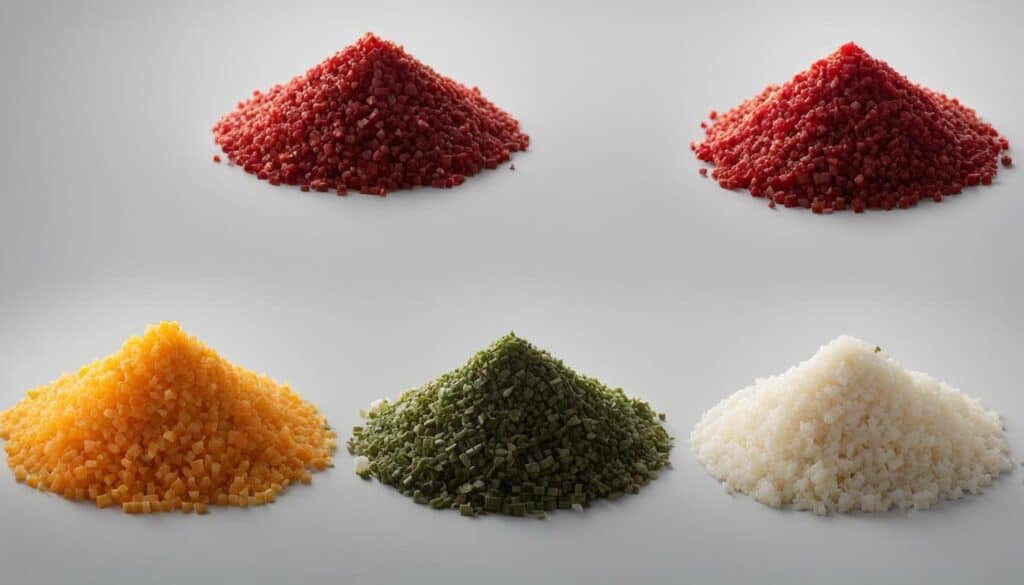
- Meredith, G. (2021). The Difference Between Chopped, Diced, and Minced. Bon Appétit. Retrieved from [insert source link].
- Rodriguez, R. (2020). Knife Skills: Mincing and Dicing. Food Network. Retrieved from [insert source link].
Mastering Knife Skills: Essential Techniques
To become a pro at dicing and mincing, you need to master the art of knife skills. Proper technique and the right tools can make a world of difference in the kitchen. Here are some essential techniques to hone your dicing and mincing skills:
- Hold the knife correctly: Grip the handle firmly with your dominant hand, while placing your index and middle fingers on the blade for stability. This grip will give you better control and prevent accidents.
- Create stability: To ensure precision cuts, use a cutting board with a non-slip surface. Place a damp towel or silicone mat underneath to prevent the board from sliding. This will help you maintain stability and avoid any mishaps.
- Use the correct cutting motion: For dicing, hold the knife at a 90-degree angle and make straight downward cuts. You can then rotate the food and repeat the cuts for evenly-sized cubes. For mincing, hold the tip of the knife against the cutting board and rock the blade back and forth, using your free hand to guide the food.
- Keep your knife sharp: A dull knife can be dangerous and lead to uneven cuts. Regularly sharpen your knife using a honing steel or have it professionally sharpened to maintain optimal performance.
By mastering these knife skills, you’ll be able to dice and mince ingredients with ease, saving time and ensuring consistent results in your cooking. Remember, practice makes perfect, so keep honing your skills and soon you’ll be dicing and mincing like a pro!
Essential Knives for Dicing and Mincing
When it comes to dicing and mincing, having the right knives in your arsenal can make all the difference. Here are three essential knives every aspiring chef should have:
| Knife | Function |
|---|---|
| Serrated Knife | Perfect for slicing through foods with tough exteriors, such as tomatoes or bread. The serrated edge helps you achieve clean, even cuts. |
| Chef’s Knife | A versatile knife that can handle a variety of kitchen tasks, including dicing and mincing. Its wide blade and sharp edge allow for precise cutting motions. |
| Paring Knife | Ideal for intricate tasks like peeling, trimming, and small dicing. Its small, narrow blade provides excellent control and maneuverability. |
With these knives in your collection, you’ll have the right tools to tackle any dicing or mincing job that comes your way. Remember to keep them sharp and take good care of them to ensure longevity and optimal performance.
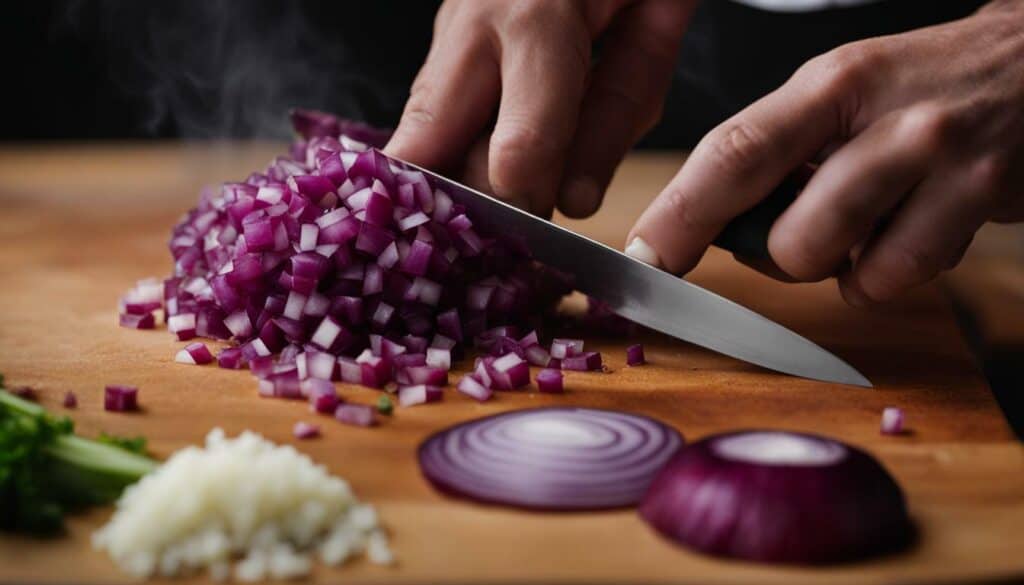
To summarize, mastering knife skills is crucial for successfully dicing and mincing ingredients. Hold the knife correctly, create stability on the cutting board, use the right cutting motion, and keep your knife sharp. Additionally, having essential knives like the serrated knife, chef’s knife, and paring knife will enhance your dicing and mincing capabilities. By honing your knife skills and using the proper knives, you’ll be able to elevate your cooking to new heights. So, grab those knives and start chopping!
Essential Knives for Dicing and Mincing
Having the right tools in your kitchen is key to achieving perfect dices and minces. When it comes to dicing and mincing ingredients, there are three essential knives that every home cook should have: the serrated knife, chef’s knife, and paring knife.
The serrated knife, also known as a bread knife, is a must-have for dicing and mincing certain ingredients. Its sharp, scalloped edge allows for clean cuts through crusty bread and tomatoes. When dicing vegetables with tough outer layers, like butternut squash or cabbage, the serrated knife’s saw-like edge helps glide through the tough skin effortlessly.
The chef’s knife is a versatile knife that can handle almost any cutting task in the kitchen. It has a broad, sharp blade that makes it perfect for dicing and mincing larger ingredients, such as onions, carrots, and meats. The extra width of the blade provides stability and control, allowing you to dice and mince with precision.
The paring knife is a small, narrow knife that is ideal for intricate dicing and mincing tasks. It is perfect for peeling and trimming small fruits and vegetables, as well as mincing garlic and herbs. Its compact size and precise control make it an essential tool for any cook.
| Knife | Usage |
|---|---|
| Serrated Knife | Dicing and mincing ingredients with tough outer layers |
| Chef’s Knife | Dicing and mincing larger ingredients |
| Paring Knife | Intricate dicing and mincing tasks |
By having these essential knives in your kitchen, you will be equipped to tackle any dicing or mincing task with ease. Remember to keep your knives sharp, as a dull blade can make the dicing and mincing process more difficult and less precise.
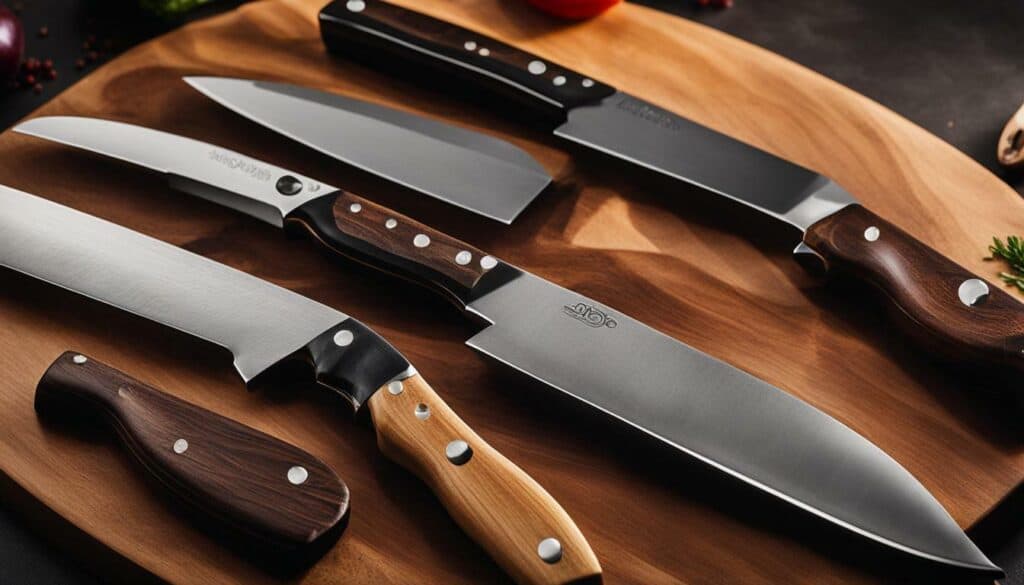
Mastering the art of dicing and mincing can elevate your cooking to the next level. With the right tools and proper knife skills, you can achieve consistent and professional-looking results. So, why not invest in these essential knives and embark on a culinary adventure in your own kitchen?
Other Cutting Methods in the Culinary World
While dicing and mincing are important techniques, there are other cutting methods worth exploring in the culinary world. These methods offer different ways to prepare and present ingredients, adding variety and visual appeal to your dishes. Let’s take a closer look at some of these techniques.
Slicing
Slicing is a basic cutting method that involves cutting food into flat, even pieces. It is commonly used for ingredients like meat, bread, and vegetables. Sliced ingredients can be used in a variety of dishes, from sandwiches to stir-fries. To achieve consistent slices, it is important to use a sharp knife and maintain a steady cutting motion.
Bias Slicing
Bias slicing is a technique where ingredients are cut at an angle, usually around 45 degrees. This method adds an elegant touch to presentations and enhances the visual appeal of your dishes. Bias-sliced ingredients are often used in salads, stir-fries, and garnishes. The angled cuts create larger surface areas, allowing the ingredients to cook more quickly and evenly.
Chiffonade
Chiffonade is a technique commonly used with leafy greens and herbs. To chiffonade, stack the leaves, roll them tightly, and cut across the roll into thin ribbons. This cutting method is perfect for adding delicate, thinly sliced greens to salads, soups, and pasta dishes.
Wedges
Wedges are a fun and versatile cutting method that involves cutting food into triangular shapes. This technique is often used for fruits and vegetables like potatoes, apples, and citrus fruits. Wedges can be roasted, grilled, or used as a decorative element in salads and platters.
By exploring these cutting methods and incorporating them into your culinary repertoire, you can elevate your cooking and create visually stunning dishes. Remember to always use a sharp knife, practice proper knife skills, and have fun experimenting with different techniques.
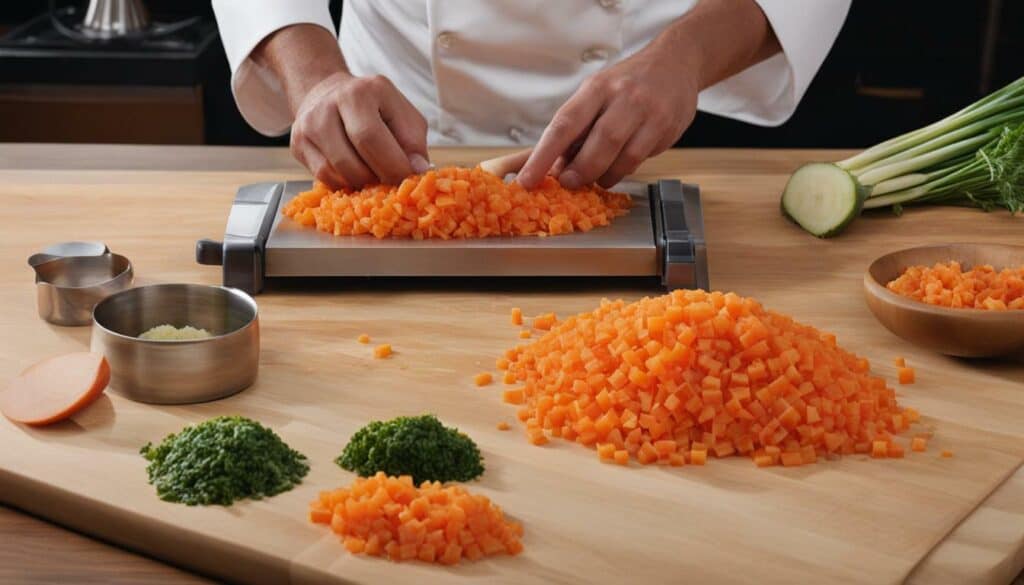
Safety is paramount when it comes to handling sharp knives in the kitchen. By following a few simple guidelines, you can ensure that your cutting experience is both safe and efficient.
First and foremost, always make sure that your knives are sharp. A dull blade requires more force, increasing the risk of slipping and causing accidents. Regularly sharpening your knives will not only make your cutting tasks easier but also minimize the chances of accidents.
When using the dicing or mincing techniques, it is crucial to maintain a firm grip on the knife handle. This provides better control over the blade and reduces the risk of losing control while cutting. Additionally, always use a cutting board that is stable and non-slip to prevent any unexpected movements during the cutting process.
Another important tip is to use the knife in a rocking motion when mincing or dicing. This technique involves pivoting the knife back and forth, using the full length of the blade to effortlessly chop through the ingredients. Not only does this make your cutting more efficient, but it also ensures a consistent and even result.
Mastering Knife Skills: Essential Techniques
By mastering the art of dicing and mincing, you can elevate your cooking skills to a whole new level. The right techniques combined with the proper knife skills will not only save you time in the kitchen but also enhance the presentation and flavor of your dishes.
“Proper knife skills are essential for achieving precise and uniform cuts in your ingredients. Practice and patience are key to mastering these techniques, and with time, you’ll become more confident in your abilities.”
Remember, always prioritize safety and take your time when handling sharp knives. With practice and these tips in mind, you’ll soon become a pro at dicing and mincing!
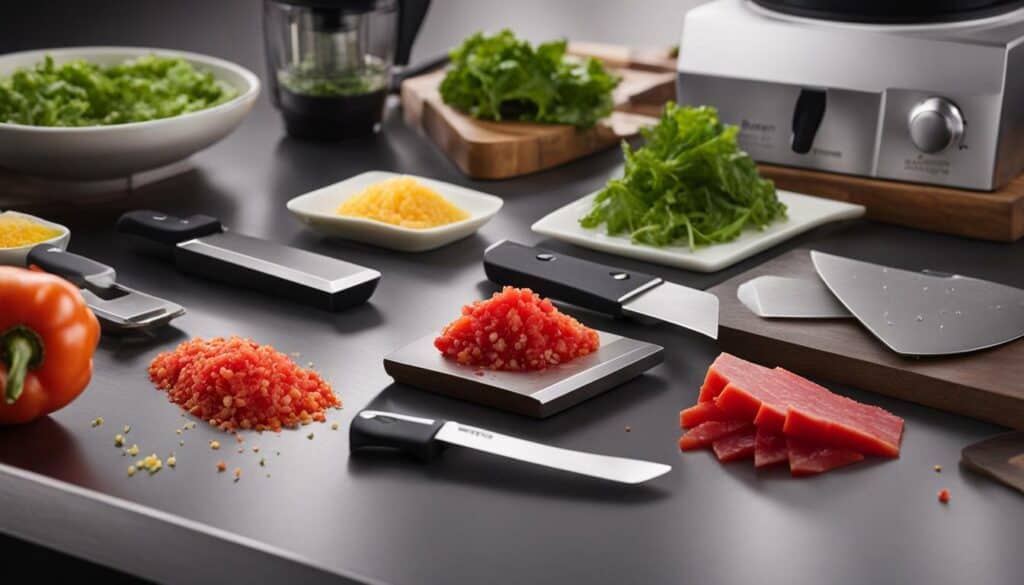
Armed with the knowledge of diced vs minced, you are now ready to elevate your culinary creations by mastering these essential cutting techniques. Dicing and mincing are two fundamental methods used in cooking, each with its own advantages and uses.
When it comes to dicing, this technique involves cutting food into uniform cubes, which is perfect for creating visually appealing dishes and ensuring even cooking. Diced ingredients are commonly used in recipes that call for specific measurements and require a consistent texture. Vegetables and fruits are often diced to add color, texture, and flavor to salads, stir-fries, or stews.
Mincing, on the other hand, is the process of finely chopping ingredients into tiny pieces. This method is ideal for enhancing the flavor and aroma of herbs and garlic. Mincing allows these ingredients to blend seamlessly into sauces, dressings, or marinades, providing a burst of flavor in every bite. Finely minced ingredients can also be used as a garnish to add a pop of freshness and complexity to a dish.
To effectively dice or mince ingredients, it is essential to have the right tools and proper knife skills. Three indispensable knives for these cutting techniques are the serrated knife, chef’s knife, and paring knife. Mastering these techniques will not only save you time in the kitchen but also give you the confidence to experiment with different flavors and textures in your recipes.
As you continue to explore the culinary world, keep in mind that dicing and mincing are just two of the many cutting methods available to you. Other techniques such as slicing, bias slicing, chiffonade, and wedges can add variety and visual interest to your meals. However, mastering the basics of dicing and mincing will provide a solid foundation for your culinary endeavors.
So, roll up your sleeves, grab your knives, and start practicing your dicing and mincing skills. With time and practice, you will become more proficient in these essential techniques, allowing you to create impressive and delicious dishes that are sure to impress family and friends.
FAQ
Q: What is the difference between dicing and mincing?
A: Dicing involves cutting food into neat, uniform cubes, while mincing results in finely chopped ingredients.
Q: When should I use diced ingredients?
A: Diced ingredients are often used for vegetables and fruits.
Q: When should I use minced ingredients?
A: Minced ingredients are commonly used for herbs and garlic.
Q: What knives are essential for dicing and mincing?
A: The serrated knife, chef’s knife, and paring knife are three essential knives for dicing and mincing.
Q: What are some other cutting methods used in cooking?
A: Other cutting methods include slicing, bias slicing, chiffonade, and wedges.
Q: How can I improve my knife skills for dicing and mincing?
A: Proper grip and stability are important. Mastering knife skills can be achieved through practice and technique.
Q: Are there any safety tips for cutting in the kitchen?
A: Yes, it’s important to always use a sharp knife, keep fingers away from the blade, and maintain a stable cutting surface.
Which is more nutritious, kale or spinach?
When it comes to the kale and spinach comparison, both leafy greens pack a nutritional punch. Kale is a powerhouse, rich in vitamins A, C, K, and minerals like iron and calcium. However, spinach isn’t far behind, boasting similar nutrients with the addition of folate. Ultimately, incorporating both into your diet ensures a diverse range of nutrients.

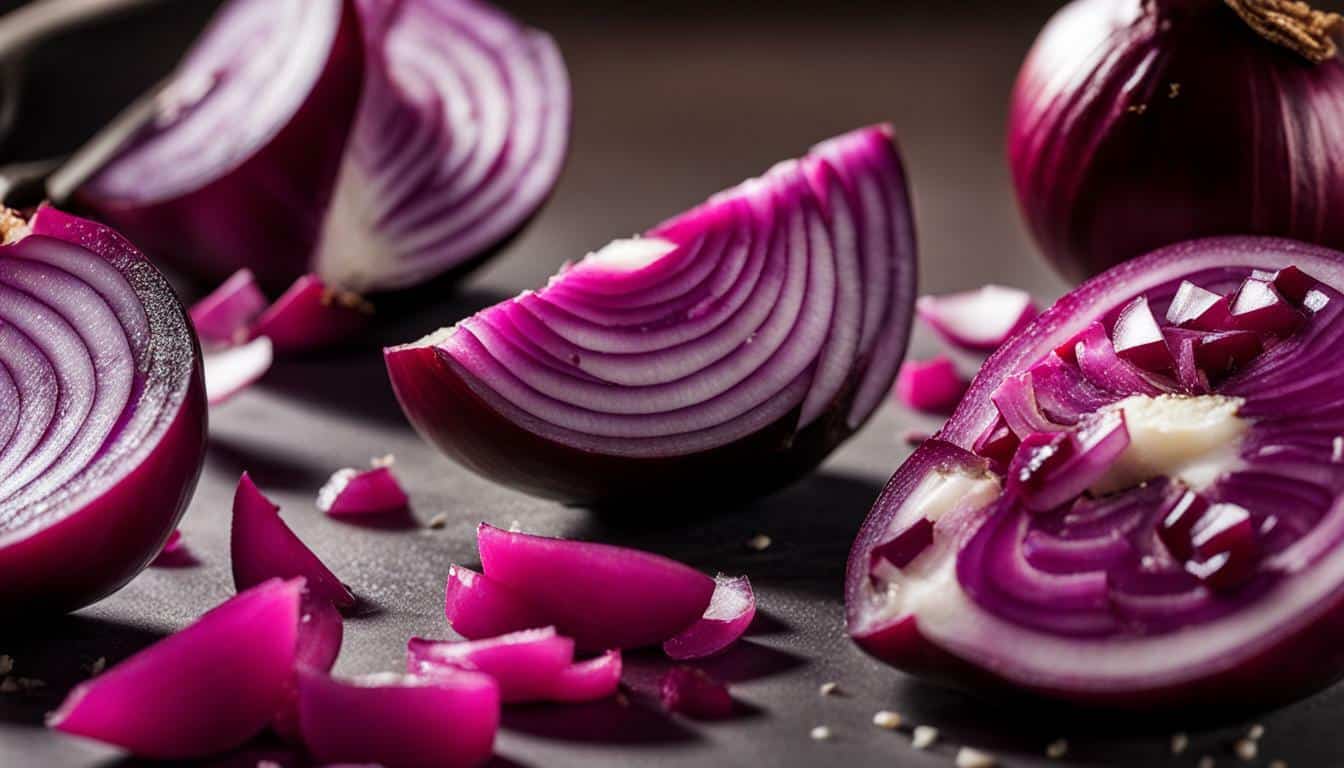
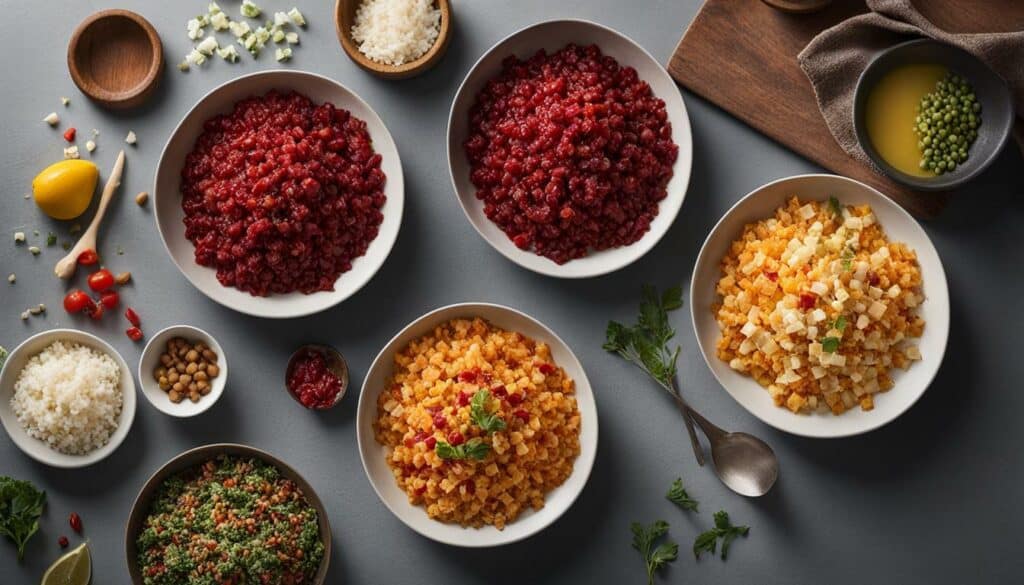
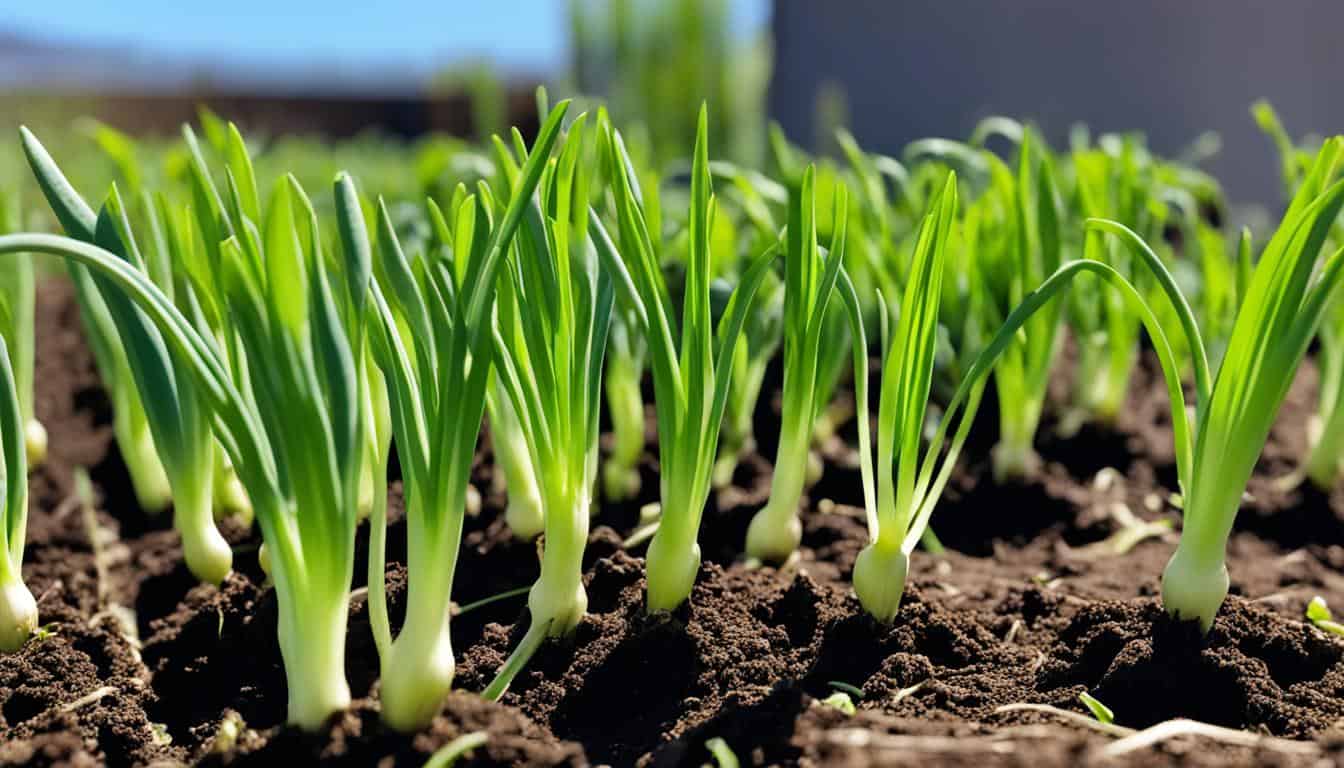
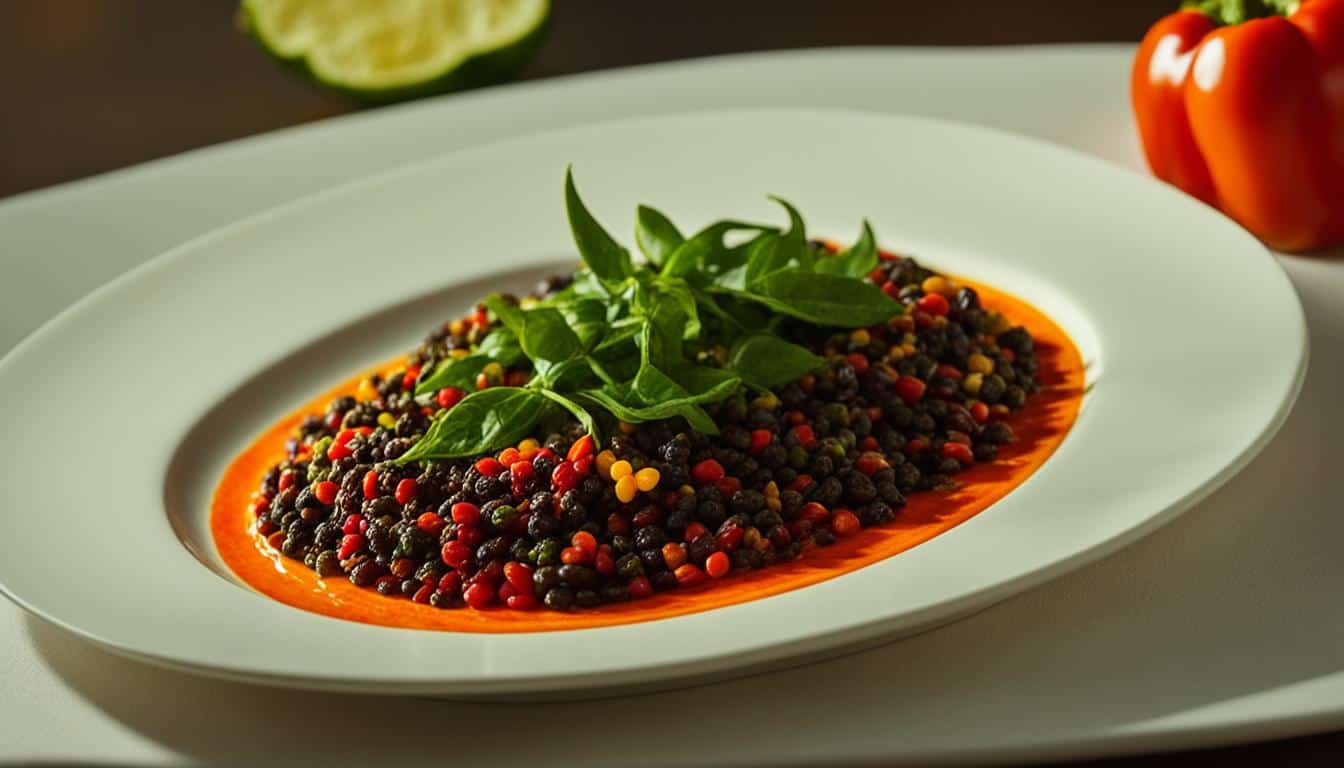
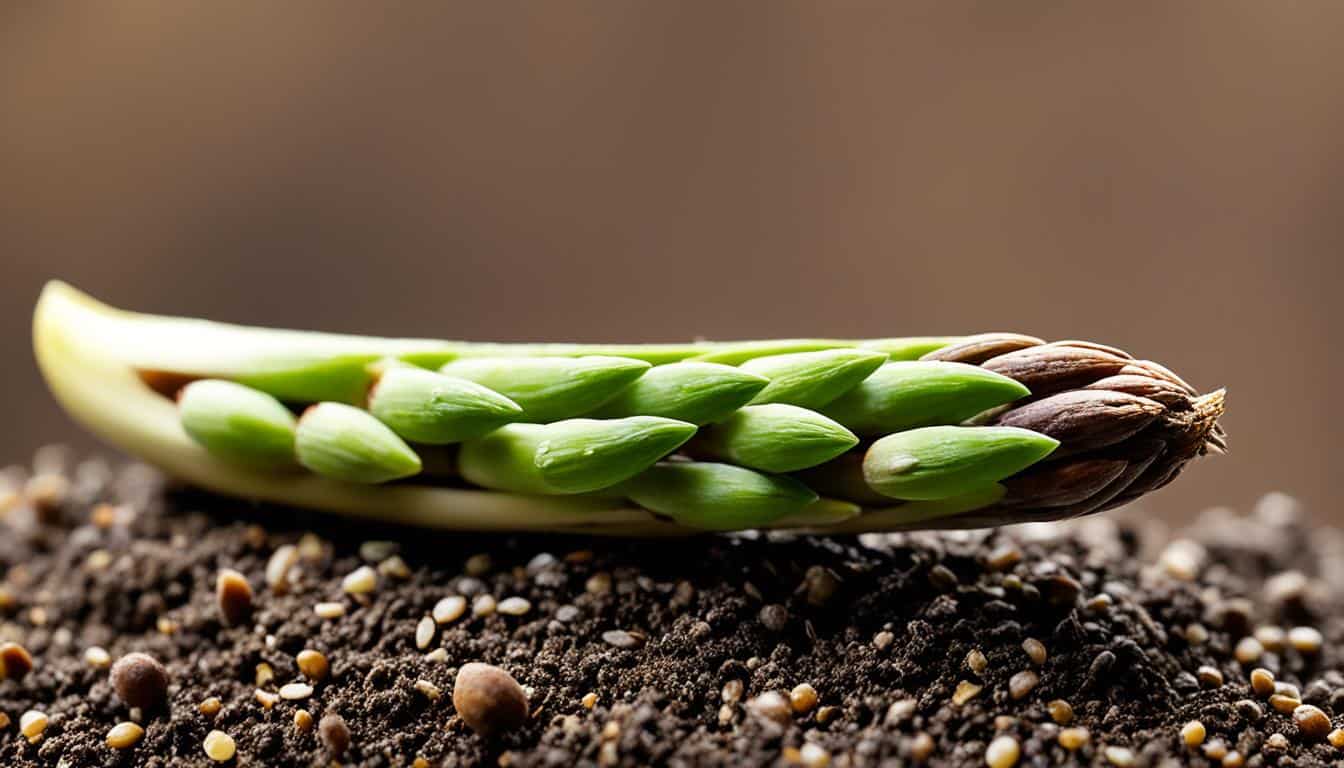
Leave a Reply